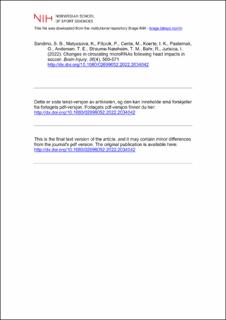| dc.contributor.author | Sandmo, Stian Bahr | |
| dc.contributor.author | Matyasova, Katarina | |
| dc.contributor.author | Filipcik, Peter | |
| dc.contributor.author | Cente, Martin | |
| dc.contributor.author | Koerte, Inga Katharina | |
| dc.contributor.author | Pasternak, Ofer | |
| dc.contributor.author | Andersen, Thor Einar | |
| dc.contributor.author | Straume-Næsheim, Truls Martin | |
| dc.contributor.author | Bahr, Roald | |
| dc.contributor.author | Jurisica, Igor | |
| dc.date.accessioned | 2023-02-14T07:34:24Z | |
| dc.date.available | 2023-02-14T07:34:24Z | |
| dc.date.created | 2022-03-25T10:21:39Z | |
| dc.date.issued | 2022 | |
| dc.identifier.citation | Brain Injury. 2022, 36(4), 560-571. | en_US |
| dc.identifier.issn | 0269-9052 | |
| dc.identifier.uri | https://hdl.handle.net/11250/3050531 | |
| dc.description | Dette er siste tekst-versjon av artikkelen, og den kan inneholde små forskjeller fra forlagets pdf-versjon. Forlagets pdf-versjon finner du her: tandfonline.com / This is the final text version of the article, and it may contain minor differences from the journal's pdf version. The original publication is available here: tandfonline.com | en_US |
| dc.description.abstract | Aim: To explore the short-term effects of accidental head impacts and repetitive headers on circulating microRNAs, accounting for the effects of high-intensity exercise alone. Methods: Blood samples were collected from professional soccer players at rest. Repeat samples were drawn 1 h and 12 h after three conditions: (1) accidental head impacts in a match, (2) repetitive headers during training, and (3) high-intensity exercise. 89 samples were screened to detect microRNAs expressed after each exposure. Identified microRNAs were then validated in 98 samples to determine consistently deregulated microRNAs. Deregulated microRNAs were further explored using bioinformatics to identify target genes and characterize their involvement in biological pathways. Results: Accidental head impacts led to deregulation of eight microRNAs that were unaffected by high-intensity exercise; target genes were linked to 12 specific signaling pathways, primarily regulating chromatin organization, Hedgehog and Wnt signaling. Repetitive headers led to deregulation of six microRNAs that were unaffected by high-intensity exercise; target genes were linked to one specific signaling pathway (TGF-β). High-intensity exercise led to deregulation of seven microRNAs; target genes were linked to 31 specific signaling pathways. Conclusion: We identified microRNAs specific to accidental head impacts and repetitive headers in soccer, potentially being useful as brain injury biomarkers. | en_US |
| dc.language.iso | eng | en_US |
| dc.subject | repetitive head impacts | en_US |
| dc.subject | subconcussive | en_US |
| dc.subject | traumatic brain injury | en_US |
| dc.subject | soccer | en_US |
| dc.subject | football | en_US |
| dc.subject | microRNA | en_US |
| dc.subject | neurodegeneration | en_US |
| dc.title | Changes in circulating microRNAs following head impacts in soccer | en_US |
| dc.type | Peer reviewed | en_US |
| dc.type | Journal article | en_US |
| dc.description.version | acceptedVersion | en_US |
| dc.source.pagenumber | 560-571 | en_US |
| dc.source.volume | 36 | en_US |
| dc.source.journal | Brain Injury | en_US |
| dc.source.issue | 4 | en_US |
| dc.identifier.doi | 10.1080/02699052.2022.2034042 | |
| dc.identifier.cristin | 2012482 | |
| dc.description.localcode | Institutt for idrettsmedisinske fag / Department of Sports Medicine | en_US |
| cristin.ispublished | true | |
| cristin.fulltext | postprint | |
| cristin.qualitycode | 1 | |
